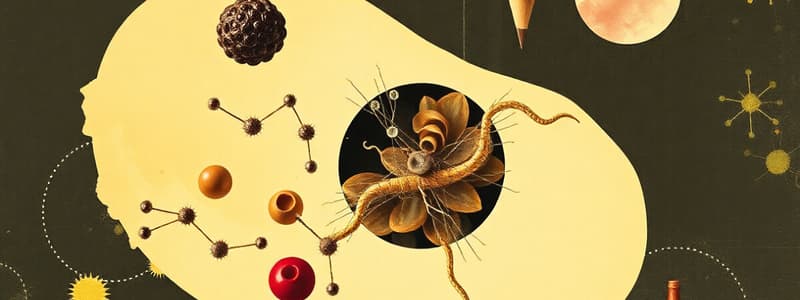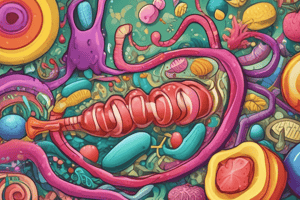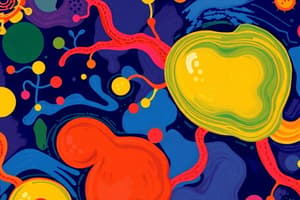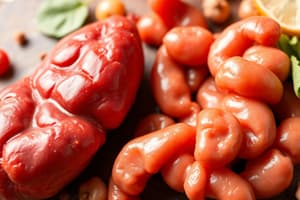Podcast
Questions and Answers
What percentage of lipids are made up of triacylglycerol?
What percentage of lipids are made up of triacylglycerol?
- 90% (correct)
- 70%
- 80%
- 95%
Why are lipids emulsified during digestion?
Why are lipids emulsified during digestion?
- To make them less hydrophobic
- To increase their solubility in water
- To reduce their bulkiness for absorption
- To create a larger surface area for digestive enzymes (correct)
What type of lipase is secreted in saliva but only activates in the stomach?
What type of lipase is secreted in saliva but only activates in the stomach?
- Pancreatic lipase
- Lingual lipase (correct)
- Gastric lipase
- Colipase
In the stomach, what role does gastric lipase primarily serve?
In the stomach, what role does gastric lipase primarily serve?
What results from the breakdown of triglycerides by pancreatic lipase?
What results from the breakdown of triglycerides by pancreatic lipase?
Which statement is true regarding the digestion of fats in children compared to adults?
Which statement is true regarding the digestion of fats in children compared to adults?
What is the primary chemical nature of cholesterol?
What is the primary chemical nature of cholesterol?
What prevents triglycerides from passing through the mucosal cell membrane?
What prevents triglycerides from passing through the mucosal cell membrane?
What compound is formed from the breakdown of phosphatidyl-choline by phospholipase A2?
What compound is formed from the breakdown of phosphatidyl-choline by phospholipase A2?
Which of the following enzymes is responsible for activating phospholipase A2?
Which of the following enzymes is responsible for activating phospholipase A2?
What components are released by micelles in the jejunum?
What components are released by micelles in the jejunum?
What happens to fatty acyl CoA once inside an intestinal cell?
What happens to fatty acyl CoA once inside an intestinal cell?
Which statement is true regarding the absorption of micelles in the intestine?
Which statement is true regarding the absorption of micelles in the intestine?
What is the primary lipid distributed by chylomicrons?
What is the primary lipid distributed by chylomicrons?
What happens to chylomicron remnants after they are depleted of triglycerides?
What happens to chylomicron remnants after they are depleted of triglycerides?
Which lipoprotein primarily delivers triglycerides from the liver to tissues?
Which lipoprotein primarily delivers triglycerides from the liver to tissues?
What component forms the hydrophilic shell of a chylomicron?
What component forms the hydrophilic shell of a chylomicron?
What is the role of apolipoprotein B-48 in chylomicrons?
What is the role of apolipoprotein B-48 in chylomicrons?
What component of lipoproteins is responsible for metabolism and recognition?
What component of lipoproteins is responsible for metabolism and recognition?
What happens to glycerol after triglycerides in chylomicrons are broken down?
What happens to glycerol after triglycerides in chylomicrons are broken down?
Which apoprotein is essential for the activation of lipoprotein lipase?
Which apoprotein is essential for the activation of lipoprotein lipase?
What lipoproteins scavenge cholesterol from dying cells and trap it as cholesterol ester?
What lipoproteins scavenge cholesterol from dying cells and trap it as cholesterol ester?
Flashcards
Triacylglycerol percentage
Triacylglycerol percentage
90% of lipids are composed of triacylglycerol.
Lingual lipase activation
Lingual lipase activation
Lingual lipase in saliva does not activate until the stomach.
Acid-stable lipase
Acid-stable lipase
Lingual lipase is called acid-stable lipase due to low pH function.
Gastric lipase activation pH
Gastric lipase activation pH
Signup and view all the flashcards
Fatty acid length for gastric lipase
Fatty acid length for gastric lipase
Signup and view all the flashcards
Lipids in the stomach
Lipids in the stomach
Signup and view all the flashcards
Bile components
Bile components
Signup and view all the flashcards
Pancreatic lipase function
Pancreatic lipase function
Signup and view all the flashcards
Pancreatic Cholesterol Esterase
Pancreatic Cholesterol Esterase
Signup and view all the flashcards
Phospholipase A2
Phospholipase A2
Signup and view all the flashcards
Lysophospholipase
Lysophospholipase
Signup and view all the flashcards
End products of Phospholipid Catabolism
End products of Phospholipid Catabolism
Signup and view all the flashcards
Micelle
Micelle
Signup and view all the flashcards
Chylomicron
Chylomicron
Signup and view all the flashcards
Apolipoprotein B-48
Apolipoprotein B-48
Signup and view all the flashcards
Lipoprotein Lipase
Lipoprotein Lipase
Signup and view all the flashcards
Free Fatty Acids Destinations
Free Fatty Acids Destinations
Signup and view all the flashcards
VLDLs
VLDLs
Signup and view all the flashcards
LDLs
LDLs
Signup and view all the flashcards
HDLs
HDLs
Signup and view all the flashcards
Chylomicron Remnants
Chylomicron Remnants
Signup and view all the flashcards
ApoCII's Role
ApoCII's Role
Signup and view all the flashcards
Study Notes
Lipid Digestion and Transport
-
Triglyceride Percentage: Approximately 90% of lipids are triacylglycerols.
-
Lingual Lipase Activation: Lingual lipase, secreted in saliva, requires a low pH environment (stomach acid) to become active. It's also called acid-stable lipase.
-
Gastric Lipase Activity: Gastric lipase, produced in the stomach, is activated at a neutral pH, primarily working on triglycerides with shorter and medium-chain fatty acids.
-
Infant Fat Digestion: Infants have more significant fat digestion in the stomach due to lower stomach acidity, allowing gastric lipase to function more efficiently.
-
Primary Lipid Digestion Site: Most lipid digestion begins in the duodenum.
-
Lipid Digestion Prerequisites: Lipids in the stomach are typically not fully digested because they aren't yet emulsified.
-
Emulsification: Lipids are emulsified (broken into smaller droplets) to increase the surface area, allowing digestive enzymes easier access. This is crucial due to the low water solubility of lipids.
-
Bile Components: Bile salts (precursors to bile acids) are hydrophilic (water-loving), while cholesterol and lipids are hydrophobic (water-fearing). Bile's structure allows it to emulsify fat by having a hydrophobic portion near fat and a hydrophilic portion interacting with water.
-
Bile Acid/Salt Production: Bile salts are produced by the liver and put into the bile. Intestinal bacteria convert some bile salts to bile acids.
-
Lipid Absorption Barriers: Triglycerides, too large to penetrate intestinal cell membranes, need breakdown into smaller components.
-
Pancreatic Lipase Action: Pancreatic lipase breaks down triglycerides into 2 free fatty acids and 2-monoacylglycerol.
-
Cholesterol Ester Breakdown: Pancreatic cholesterol esterase breaks down cholesterol esters into cholesterol and a fatty acid.
-
Phospholipid Breakdown: Phospholipase A2, activated by trypsin, breaks down phospholipids into lysophospholipid and fatty acid.
-
Lysophospholipid Breakdown: Lysophospholipase breaks down lysophospholipids into glyceryl-phosphorylcholine and a fatty acid.
-
Phospholipid Catabolism Products: Phospholipid catabolism produces 2 fatty acids and glyceryl-phosphorylcholine.
-
Lipid Catabolism End Products: Major lipid catabolism products in the intestine include fatty acids, cholesterol, and 2-monoacylglycerol.
-
Micelle Formation: A micelle is a complex containing lipid catabolites and bile salts, crucial for transporting lipid components through the intestinal environment.
-
Bile Salt/Acid Absorption: Bile salts and bile acids are predominantly absorbed in the ileum.
-
Lipid Transport in Blood: Absorbed bile salts and acids are transported in the blood, attached to albumin, within the hepatic portal system.
-
Micelle Lipid Catabolite Release: Micelles release their lipid components (e.g., fatty acids, cholesterol) in the jejunum for absorption by intestinal cells.
-
Lipid Uptake in Intestinal Cells: Fatty acids are initially converted to fatty acyl-CoA inside intestinal cells.
-
Triglyceride Reformation: Fatty acyl-CoA and 2-monoacylglycerol combine to reform triglycerides within intestinal cells
-
Fatty Acid Chain Lengths: Acyltransferases add long-chain fatty acids to triglycerides; short-chain fatty acids are absorbed differently (directly into bloodstream).
-
Lipid Reconfiguration Inside Cells: Triglycerides, cholesterol esters, and phospholipids are broken down into smaller components, then re-assembled into larger molecules inside the intestinal cells to be further transported.
-
Chylomicron Formation: Dietary lipids (triglycerides, cholesterol esters) and apoproteins form a chylomicron.
-
Chylomicron Components: Chylomicrons contain triglycerides, cholesterol esters, phospholipids, and apoproteins.
-
Apoproteins and Chylomicrons: Apoproteins provide structure, cell recognition, and lipoprotein metabolism for chylomicrons. Apolipoprotein B-48 is made by intestinal mucosal cells and incorporated into chylomicrons.
-
Chylomicron Exocytosis: Chylomicrons are released from intestinal cells, entering the lymphatic system via intestinal lacteals.
-
Chylomicron Entry to Blood: Chylomicrons enter the blood circulation through the left subclavian vein.
-
Lipid Use by Tissues: Triglycerides are primarily used by skeletal muscle for energy and adipose tissue for storage.
-
Chylomicron Breakdown: Lipoprotein lipase breaks down triglycerides in chylomicrons into free fatty acids and glycerol.
-
Fatty Acid Fate: Free fatty acids can diffuse into neighboring cells or circulate bound to albumin. Glycerol is used for liver processes (glycolysis/gluconeogenesis).
-
Chylomicron Remnants: Remaining chylomicron particles are taken up by the liver.
-
Chylomicron Remnant Composition: Residual chylomicron material contains cholesterol esters, phospholipids, apoproteins (and any remaining triglycerides).
-
Liver Actions on Cholesterol: The liver uses taken up cholesterol from chylomicron remnants to create LDLs, HDLs, and VLDLs.
-
Lipoprotein Structure Component: Apolipoproteins are crucial components for the structure, recognition, and metabolism of lipoproteins.
-
HDL Apoprotein Transfer: HDLs contribute apoproteins (apoCII, apoE) to nascent chylomicrons and VLDLs to help them mature.
-
Chylomicron Breakdown in Capillaries: Chylomicron triglycerides are broken down into free fatty acids and glycerol in capillaries.
-
Lipoprotein Breakdown Activation: ApoCII activates lipoprotein lipase when chylomicrons enter capillaries.
-
VLDL Formation: VLDLs are created from remnants of chylomicrons and liver-created nascent VLDL after those enter capillaries.
-
LDL Formation: LDLs come from VLDLs after the loss of triglycerides in capillaries.
-
HDL production location: HDL is produced in the liver.
-
Lipoprotein Roles: Chylomicrons transport dietary fats; VLDLs transport triglycerides from the liver to tissues; LDLs deliver cholesterol to tissues; and HDLs scavenge cholesterol, transporting it to the liver.
-
Adipocyte Response: Hormone-sensitive lipase is activated by adipocytes to break down stored triglycerides when necessary.
Studying That Suits You
Use AI to generate personalized quizzes and flashcards to suit your learning preferences.




